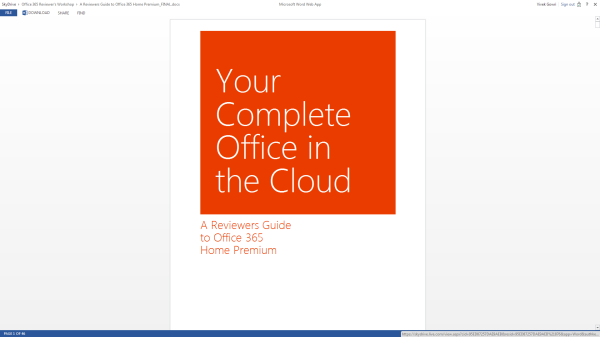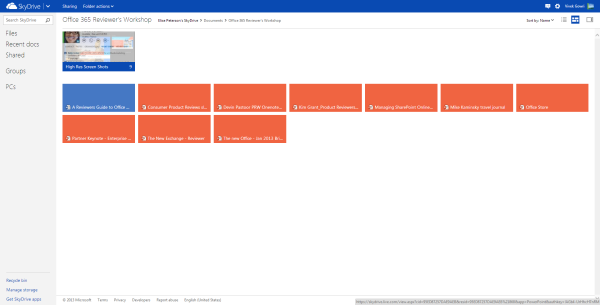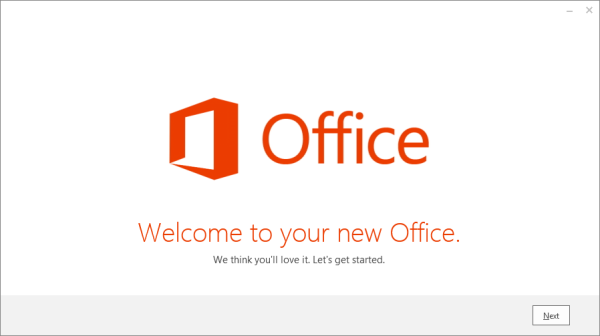Three Months with Microsoft's Office 365
by Vivek Gowri on January 31, 2013 11:59 PM EST- Posted in
- Microsoft
- Cloud Computing
- Office 2013
- SkyDrive
How big is Microsoft pushing the cloud integration in Office 2013? After signing into a Microsoft account, SkyDrive is the default save location in all Office apps, replacing the local My Documents folder. That’s an important distinction, because SkyDrive is a huge part of the Office 365 message (and likewise, Office integration is a huge part of SkyDrive’s appeal).
Combined with Office Web Apps in SkyDrive, the Office+SkyDrive combination is actually a pretty powerful way of creating and editing documents and presentations from the web, much more so than Google Docs is. And in that, I think Office 365 makes some huge strides in matching the convenience factor of Google’s purely online document creation tools, except with all the versatility and formatting power that comes with proper Office.
Sharing files from SkyDrive is also a breeze, much like Dropbox. And honestly, between the cheaper storage upgrades and Office integration, SkyDrive looks like a pretty compelling option for cloud storage when compared to Dropbox. Microsoft is doing a good job of leveraging its own products and services for better online integration, and that’s really one of the main stories in the new Office.
I’m coming away from Office 365 a big fan of the Office 2013 suite, along with a newfound appreciation of SkyDrive. The combination is a potent one, and could make the lives of students and professionals much, much easier. Unlike many Microsoft software redesigns of years past, including Windows 8, I don’t have too much in the way of misgivings about this one. The improvements are pretty comprehensive, and offer a more streamlined, polished, and visually refined user experience. That’s about all you can ask from an office suite.
My real questions center primarily around the subscription model. And even that is mostly limited to single or dual user families that don’t have access to a University subscription or Microsoft’s historically lenient home use agreements for commercial licenses. The $99 yearly price for Office 365 is pretty steep if you don’t make use of either the multi-computer install capabilities or the cloud services. I’d say in that case, you’re probably better off just getting a standalone Office 2013 license and signing up for a SkyDrive account which comes with 7GB of free storage. If you really need more storage, the 20GB upgrade only costs $10 per year, which isn’t bad at all. Or, alternatively, you could pay a student to get you an Office 365 University serial number on the cheap. [Update: I was joking about this part, sorry if it didn't come across that way. Yes, it violates the EULA, so no, don't do this.]
Other than that? It’s great. If you’ve got 4 or 5 computers to install Office on, $99/year isn’t bad at all, and for students that can get the University license, $79 for 4 years is a bargain considering that it comes with 20GB of SkyDrive storage for that four year stretch of time. If you have Office 2010 and are happy with it, I wouldn’t say you need to upgrade though the cloud integration makes that a compelling option, but for users of any previous edition Office, I’d seriously recommend making the transition.













113 Comments
View All Comments
colonelpepper - Friday, February 1, 2013 - link
this "article" is so obviously an advertisement... what an embarassment for anandtech.shame on you guys
..and on all the microsoft shills polluting this comment section.
what a friggin embarrassmet Anandtech. UNBELIEVABLE
ggathagan - Saturday, February 2, 2013 - link
As opposed to everything you've written.By your standard, you are a LibreOffice 'shill'.
As others have stated, the fact that Vivek happens to like the features of Office 2013 doesn't make him a shill, any more than your opinions make you a LibreOffice shill.
You may not have noticed, but there's no one with a gun to your head demanding that you use any MS product.
Feel free to live your entire life without a single MS product in your home.
That's the beauty of choice
versesuvius - Saturday, February 2, 2013 - link
Why pay all that money, when you can keep all that money. Open office is not as pretty, depending on one's moods and tastes of course, but it is ten times more reliable and in the long run more productive than any MS Office n-1.mechBgon - Saturday, February 2, 2013 - link
...exploitable, maybe. CERT's security shootout, have a look at the third chart:https://www.cert.org/blogs/certcc/2011/04/office_s...
Quality code, for a premium price. Choose your preference, I guess.
That said, I would probably get Office 2010 over Office 2013 at this point, since Office 2013 licenses can't be transferred to one's next PC. That's right, it's like an OEM Windows license, irrevocably licensed to the first PC you activate it on. And if you want to use it on your desktop and your laptop/tablet, Office 2013 requires you to buy a second license, whereas Office 2010 doesn't.
It appears to me that Microsoft is purposely poisoning Office 2013 with these licensing shens to get more people onto the subscription model.
versesuvius - Sunday, February 3, 2013 - link
I will not argue with that test, but my own experience is somewhat different. Apache Open office is in 3.4 version now and keeps getting better. In Europe, many governments and city authorities have adopted Open Office since its early versions (before Oracle and Apache), and that shows that the crash problems and productivity then were much more in favor of Open Office and with the latest improvements the situation has not changed much. Anyway for small business and individuals,if not with enterprises, Open Office makes a compelling case. After all 30,000,000 downloads for Apache Open Office alone is bound to make it a more viable platform every day. And again, it is free.mechBgon - Sunday, February 3, 2013 - link
You mean, the _up-front cost_ is free. How about the TCO? Microsoft has some compelling advantages there. Installation, security, updating, auditing, and configuration enforcement are all centrally manageable with Group Policy, WSUS, and MBSA, among other tools.It certainly beats hand-installing and hand-configuring a thousand workstations, wondering if the employees have altered the security configuration, wondering if they're up-to-date, and knowing that you had to allow Admin rights to update the software. Over the course of a 3-5 year lifecycle, which one's really cheaper? And how much does a security breach cost?
Then there's Open Office's deplorable inclusion of a Java Runtime Environment by default. If they were deliberately attempting to create a security liability, that's a great opening move.
versesuvius - Sunday, February 3, 2013 - link
Very few open source software updates like paid software. The reason for that is simply the fact that updating automatically requires an online server or actually many servers, which costs money. The free software only gives you a notification and the update is usually a download and an install into the same directory. But that does not mean that updating many installation has to be done manually. It can be done automatically through scripts or other methods. As I said governments in Europe have adopted Open Office since many years ago and they are very likely to have security as a high priority on their list. Anyway, all that you mention can be done through either OS services, with Linux being very good at it, or through scripts which any serious enterprise easily has the resources available for and in place already. An interesting point is that contrary to what you say, when it comes to thousands of installations the first time installation make the cost of Open Office almost the same as MS Office. (I remember in a European city, Microsoft's bid was lower than Open Office's, but the city went ahead with Open Office anyways). After that it is almost free with Open Office and permanently very costly with MS Office. I remember Microsoft at a time was offering the entire office suite for 3 dollars in China. It was done to combat piracy, but the end result is the same. It is the long run profits that Microsoft makes that is important to the company, not the initial payment.HisDivineOrder - Saturday, February 2, 2013 - link
...for a lot of users. I think you really covered that. You'd think they'd want to get everyone on the MS teet, suckling that Office goodness in a subscription they'd get for years and years to come. Just like you said, getting us to pay for more and more devices to have access.Instead, they're like confused about what they want to do. On the one hand, they want to charge the same as they always do for the single license, no subscription. And on the other, they want TONS of money from subscriptions, charging an insane amount for a year's worth of use of something. If they'd shave $10 off per copy that I wouldn't use on devices, let me decide how many devices i need to have access to the subscription, then this would be a great deal for me.
Otherwise, I don't think they get who their competition really is. Sure, they're competing with Google Docs, LibreOffice, OpenOffice, etc. But that's not the real competition they should be afraid of.
They should be afraid of everyone who has Office 2010/2007 who is looking at this and shrugging. Most of what 2013 offers in Skydrive functionality that ordinary users would appreciate can be duplicated by changing your FREE Skydrive account to look at your documents folder. And for anyone who had Skydrive before it was Skydrive, they have not 7 GB, but 25 GB already. I'd imagine quite a few of THOSE users already have Office 2010.
So... by pricing this in the stratosphere, they've killed any and all impulse buying of this product.
As far as I can tell from this "review," the only other real reason to get this is if you have a Touch device. How many x86 computers out there based on touch will be used via touch enough to make an Office built around touch worthwhile? How big is that audience?
flensr - Sunday, February 3, 2013 - link
No subscription for me, no way. I got office 2007 student edition back in 2007, for under $100 if I recall correctly. I'm still using it, 5 years later and have no reason to upgrade. I know how to use it, it's compatible with everything I need to do.A subscription would be a total ripoff for me and my family. I'm just not going to do it.
benedict - Sunday, February 3, 2013 - link
So Vivek graduated and got a job at Microsoft. Grats!